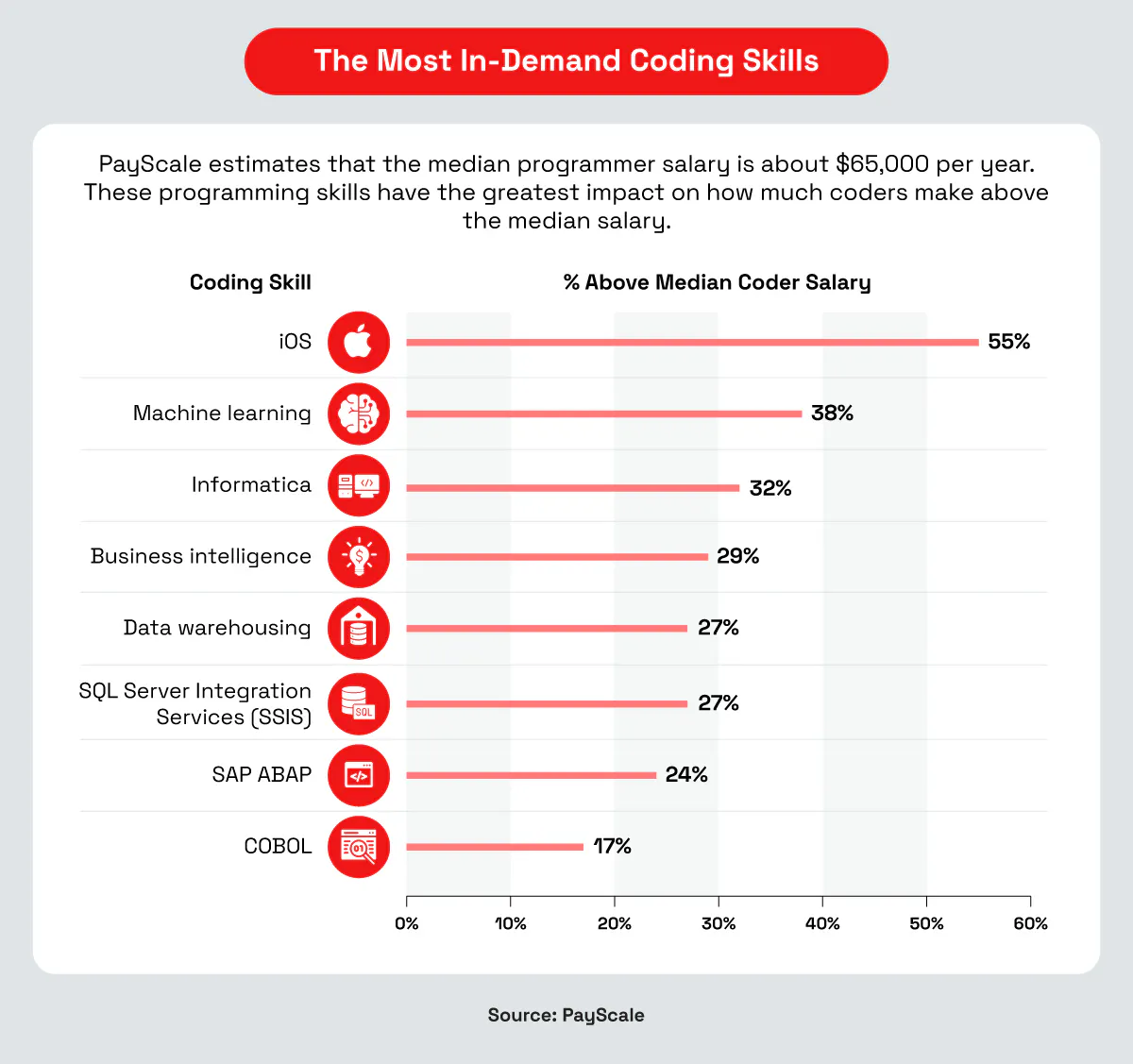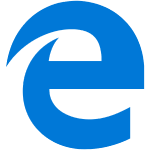Fill out the form to get more information about the Fullstack Academy bootcamp of your choice.
05.12.2025
How Much Do Coders Make? Salary Potential & Career Outlook
By The Fullstack Academy Team

Last Updated: April 2024
From mobile phones, laptops, and cars to enterprise, industrial, and space systems, the software that runs today’s technology plays a vital role throughout society. Companies in nearly every industry use software to become more efficient, more productive, and more successful.
The computers and other hardware that make technological innovations possible have their own language, and it is up to software professionals to write instructions that computers can understand. These instructions, known as code, enable software to communicate with hardware to make technology work.

But how much do coders make, and what should individuals know about pursuing coding careers? Read on to learn more about where a coding career can take you, and how much you can expect to earn along the way.
In this article, we’ll explore:
What Is Coding?
Before looking at coding roles and salaries, it’s important to answer the question, “what is coding?” The term “coding” describes the use of a programming language to instruct a computer to perform a specific operation or set of operations, including inputting, processing, outputting, storing, and controlling. The two primary types of programming are low-level and high-level programming. Understanding the primary types of programming is the first step in distinguishing between the many coding roles available.
Low-Level Programming
Low-level programming uses native computer language to provide basic instructions to a CPU. The two primary types of low-level programming language are machine language and assembly language. Machine language contains binary code made up of 1s and 0s. Assembly language is a slightly more advanced than machine language level and includes commands that enable computers to perform basic operations, including calculations and registry instructions. Humans cannot typically read these languages.
High-Level Programming
High-level programming is oriented toward end-users, enabling programmers to write code from algorithms. It is important to note that CPUs do not directly understand high-level language; high-level language is compiled into a low-level language to translate it for CPUs. High-level languages can be categorized as third, fourth, or fifth generation. Third-generation languages include Java and JavaScript, while fourth-generation languages include PHP, Python, and SQL. Some of the newest languages, such as Mercury, OPS5, and Prolog, are considered fifth-generation.
Software will continue to be the driving force of the current digital transformation. As software becomes more advanced and innovations such as artificial intelligence (AI) and machine learning take on bigger roles in society and business; coding will continue to grow in importance, creating more opportunities for professionals with the right background.
Ready to break into tech?
Learn the #1 programming language in 13 weeks with our full-time coding bootcamp.
Why Learn Coding Skills?
The tech industry is booming, and skilled coders are in high demand. Learning to code opens doors to exciting career opportunities with excellent earning potential. Here are some compelling reasons to equip yourself with coding skills:
Pursue Rewarding Careers: The tech industry is booming, and skilled coders are in high demand. This translates to plentiful job opportunities and strong salaries across various industries.
Increase Earning Potential: Coders consistently rank among the highest-paid professions. Learning to code can significantly improve your earning potential.
Boost Problem-Solving Skills: Coding fosters logical thinking and problem-solving abilities, valuable assets in any field.
Future-Proof Your Career: Coding is a future-proof skill that remains relevant across various industries.
If you're looking for a challenging and rewarding career path, or simply want to enhance your skill set and explore your creativity, then learning to code is an excellent investment in your future. As you read along, you’ll understand how a coder’s salary can range based on their role, industry, experience, education, and location.
Computer Coding Salary and Salaries of Related Fields
From database developer to web developer and digital designer, there are many different types of software careers–each with its own responsibilities, specializations, and earning potential. Still, they typically share a common trait: they’re all in high demand, which often translates into competitive salaries. Below are some examples of how much coders make.
Computer Programmer Salary
The overall median salary for computer programmers is $61,742, according to Indeed. Individuals in entry-level positions typically earn far less than those with years of experience in the field. The median annual salary for individuals in the lowest 10% is around $46,111, while the highest 10% has a median annual salary of more than $82,672.
BLS occupational employment and wage statistics suggest that geography is a major determining factor of salary for computer programmers. For example, the highest-paying states for computer programmers in 2024 are Washington and California, with mean annual salaries of $76,090 and $64,992 respectively.
Web Developer Salary (Full-Stack Developer Salary)
The overall median salary for web developers ranges around $64,613 in April 2024, according to Payscale. The range of salary for web developers can vary based on experience. For example, the median salary for an entry-level web developer (less than one year of experience) is $52,224, while the median salary for experienced web developers (ten or more years of experience) is around $78,375.
Geography also plays a role in web developer salaries. For example, web developers in certain tech cities like San Francisco, Los Angeles, and New York earn higher salaries than the nationwide average.
Web developer salaries can be further broken down by type:
- Front-end web developer salary: median annual salary of $83,509 as of March 2024, according to Payscale.
- Back-end web developer salary: median annual salary of $96,959 as of March 2024, according to Payscale.
Mobile App Developer Salary
There are various types of application developer roles. Mobile app developers are in high demand thanks to the proliferation of mobile devices. Mobile app developers earn a median annual salary of $84,571 as of March 2024, according to Payscale.
Less-experienced individuals typically earn much less than those with many years of experience. The median annual salary for individuals with less than one year of experience is $65,999, while those with 10-19 years of experience earn $134,914.
Another determining factor of salary for mobile app developers is location. For example, Payscale reports that mobile app developers in San Francisco, California, earn about 15.8% more than the median annual salary nationwide. Mobile app developers in Philadelphia, Pennsylvania, earn 19.8% less than the median annual salary, as reported by Payscale.
User Interface / User Experience Developer Salary
The median annual salary for user interface/ user experience (UI/UX) developers is $85,698 as of April 2024, according to Payscale. The median annual salary for individuals with less than one year of experience is around $62,934, while those with 10-19 years of experience earn an average of $111,224.
Geography can play a significant role in determining salary. Payscale reports that UI/UX developers in San Francisco, California, earn about 57% more than the median annual salary nationwide. UI/UX developers in Portland, Oregon, earn about 18% less than the median annual salary.
Database Developer Salary
The overall median salary for database developer-type roles, including database administrator and database architect, is $83,914 in 2024, according to Payscale. The salary range for database developers can vary widely. The median salary for the lowest 10% of workers is $65,370, while the median salary for the highest 10% of workers ranges around $105,188.
Geography also plays a role in database developer salaries. Database developers in New York earn about 23% more than the median annual salary, but in Las Vegas, Nevada, they earn around 24% less than the median annual salary, according to Payscale.
DevOps Salary
Development operations (DevOps) engineers earn a median annual salary of $105,841, according to Payscale. Experience typically influences DevOps salaries. The median annual salary for individuals with less than one year of experience is $79,329, while those with more than ten years of experience earn around $132,022.
Job location is a determining factor for DevOps professionals’ salaries. For example, Payscale reports that DevOps professionals in the San Francisco, California area earn 33% higher salary than the nationwide average, while those in Chicago, Illinois earn around 3% less salary on average.
Software Quality Assurance Engineer Salary
Software quality assurance engineers earn a median annual salary of $81,872 as of March 2024, according to Payscale. Salaries for software quality assurance engineers vary widely. The median salary for the lowest 10% of workers was $58,984, while the median salary for the highest 10% of workers was $111,481.
Salaries for software quality assurance engineers also vary based on location. For example, software quality assurance engineers in San Jose, California, earn around 66% more than the median annual salary, but in San Diego, California, they earn about 10% less than the median annual salary, according to Payscale.
Ready to break into tech?
Learn the #1 programming language in 13 weeks with our full-time coding bootcamp.
Coder Salaries by Industry
While tech giants and software development companies readily come to mind, skilled coders are sought after in a surprising variety of industries. Here are just a few examples, along with some insights into coder salaries:
Tech: Salaries within tech can vary depending on the specific role and company. With an average salary ranging around $93,297, tech companies encompass a broad range of specialized coding roles, according to Zippia.
E-commerce: E-commerce platforms are complex systems requiring expertise in building and maintaining the software that powers online stores, payment gateways, and recommendation algorithms. E-commerce companies pay software developers an average annual salary of $96,125, according to Payscale.
Retail: Coders are hired by e-commerce platforms to develop inventory management systems, and data analysis tools which require coding expertise, and earn around 83,412 as software developers, as reported by Payscale.
Finance: The finance industry needs coders to develop a range of tools from algorithmic trading platforms to financial analysis tools. With such a crucial role in the finance industry, software developers earn around $96,138 as an average annual salary (Zippia, April 2024).
These sectors offer exciting opportunities for developers to leverage their skills and make a real impact beyond the realm of traditional tech.
Coder Salaries by Experience
Experience is a significant factor influencing coder salaries. As you gain expertise and tackle more complex projects, your earning potential increases. According to Glassdoor data, here's a general idea of how coder salaries progress with experience:
Entry-Level: Junior coders typically work under supervision, gaining experience with core coding concepts and development processes. Entry-level software developers earn a compensation of around $98,883 on average.
Mid-Level: With a solid foundation, mid-level coders can work more independently, handle larger projects, and potentially lead small teams, earning an average salary of around $129,812.
Senior Level: Senior coders possess in-depth technical knowledge, strong problem-solving skills, and the ability to mentor junior developers giving them an average earnings of around $150,588. They often take on leadership roles and command higher salaries.
Remember, this is a general overview. Factors like specific skills, industry, and location can significantly impact your earning potential. The key is to continuously learn, refine your skills, and build a strong portfolio to showcase your expertise and value as a coder.
Coder Salaries by Education
While coder salaries can be influenced by educational background, it's not always a determining factor. Often, a strong portfolio, relevant skills, and experience can outweigh a specific degree. However, education can play a role, especially for entry-level positions. Here's a general look at how coder salaries might correlate with educational attainment:
Self-Taught Developers: Even without a formal degree, it's possible to land a coding job. The key is to develop a strong portfolio showcasing your abilities through personal projects, open-source contributions, or freelance work. According to Course Report, self-taught developers could earn around $61,836 (or higher depending on skills) for entry-level web development roles.
Coding Bootcamp or Certification: Coding bootcamps and certifications offer intensive programs focused on practical coding skills. Even without a formal degree, they can equip you for entry-level positions in coding, especially in high-demand programming languages and frameworks. As a coding bootcamp graduate, you can earn around $69,079 on average in entry-level coding roles, as reported by Course Report.
Bachelor's Degree in Computer Science or Related Field: A bachelor's degree can provide a strong foundation in computer science principles, algorithms, and data structures, making you a competitive candidate for entry-level roles. You could earn an average salary of around $77,900 in entry-level software development roles (Payscale, April 2024).
Regardless of your educational background, continuous learning and skill development are crucial for career advancement and earning potential in the ever-evolving world of coding. Fullstack Academy Coding Bootcamp is one of the top-ranked coding bootcamps, as awarded by Course Report, which prepares you to enter the coding field in around 12-28 weeks.
Coder Salaries by Location
Coder salaries can vary significantly depending on location. The cost of living is a major factor, with tech hubs like San Francisco and New York typically offering higher salaries to compensate. Here's a glimpse into how coder salaries can differ in some key cities, as reported by Zippia in April 2024:
San Francisco, CA: Often topping the charts, San Francisco offers some of the highest coder salaries due to the high cost of living and fierce competition for tech talent. Software developers in San Francisco earn an attractive annual salary of around $112,889.
Seattle, WA: Another major tech hub, Seattle offers attractive salaries for coders, with a slightly lower cost of living compared to San Francisco, paying developers around $106,416 on average.
New York, NY: New York City offers a vibrant tech scene and competitive salaries of around $91,206 for software development roles, though the cost of living remains high.
Jersey City, NJ: Situated across the river from New York City, Jersey City provides a more affordable alternative with a growing tech industry and healthy coder salaries ranging around $89,535.
Washington, DC: The nation's capital offers a stable job market for in-demand coding roles like software developers paying around $88,736, with a slightly lower cost of living compared to major coastal tech hubs.
Remember, these are just a few examples. Numerous other cities across the US offer exciting opportunities for coders, with salaries influenced by factors like local living costs and industry demand.
Factors Affecting Salaries
Several factors influence the salaries of coding professionals. Understanding these factors can help you position yourself for optimal earning potential. Here's a general overview:
Experience: As you gain expertise and tackle more complex projects, your earning potential increases. Senior coders with specialized skills typically command higher salaries than entry-level coders.
Skills: In-demand skills and specializations can significantly impact your salary. Proficiency in specific programming languages, frameworks, and tools can make you a more attractive candidate.
Location: Cost of living plays a role, with tech hubs typically offering higher salaries to compensate. However, these locations often have a higher cost of living.
Education: While a degree can be beneficial, strong skills and a portfolio are often valued more by employers. However, a coding bootcamp can help you get a strong foundation of coding skills in a shorter period and potentially lead to slightly higher starting salaries.
Company: Larger companies and those in specialized industries may offer higher salaries. Startups may offer lower salaries but potentially greater equity or ownership stake.
Negotiation: Your negotiation skills can significantly impact your starting salary. You should do your research, understand your worth, and confidently negotiate your compensation package.
By continuously developing your skills, building a strong portfolio, and staying up-to-date with industry trends, you can position yourself for a successful career as a coder with a competitive salary.
Ready to break into tech?
Learn the #1 programming language in 13 weeks with our full-time coding bootcamp.
How To Boost Your Salary as a Coder
The world of coding offers exciting career paths with strong earning potential. But how can you maximize your value and command a top coder salary? Here are some key strategies:
Continuously Learn: The tech landscape is ever-evolving. Stay ahead of the curve by dedicating time to learning the top programming languages, frameworks, and tools relevant to your field.
Master in-Demand Skills: Identify the most sought-after skills in your industry and focus on mastering them. This could involve specializing in a particular programming language, framework, or cloud platform. Some of the best coding bootcamps, like Fullstack Academy Coding Bootcamp help you gain these desired coding skills with its immersive learning in just 12 weeks (full-time) to 28 weeks (part-time) to lay a strong foundation for your coding career.
Consider Certifications: While not mandatory, industry-recognized certifications can validate your knowledge and enhance your resume, potentially increasing your earning potential.
Build a Strong Portfolio: Showcase your abilities by creating impressive projects that demonstrate your coding skills and problem-solving approach. Contribute to open-source projects or build your own applications to add to your portfolio.
Negotiate Confidently: Knowing the market value for coders with your experience and skillset will empower you to negotiate a competitive salary with confidence.
Network and Build Relationships: Connect with other coders, attend industry events, and build a strong professional network. This can open doors to new opportunities and potentially higher-paying positions.
By following these tips and demonstrating your value as a skilled and adaptable coder, you can position yourself for a successful career with a top coder salary.
Types of Coding
Different programming languages allow humans and computers to communicate for a variety of t purposes. For example, JavaScript is often used to build websites, while Python is a preferred language for statistical analysis.
Another reason behind the wide variety of programming languages is that people express ideas differently. Coders can use any number of tools to accomplish a task, based on their preferred working method and how they think.
Five Types of Programming Languages
Programming languages primarily fall under five types: procedural, functional, object-oriented, scripting, and logic.
1. Procedural
Procedural programming involves writing code that calls out a procedure, also known as a routine or function, that instructs a computer to take certain computational steps. Languages used in procedural programming include C, Java, and Pascal.
2. Functional
Functional programming is used to build software through pure functions. The code calls out sequential functions that take in an input value and return an output value. Languages used in functional programming include Scala, Scheme, Haskell, and SML.
3. Object-Oriented
Object-oriented programming (OOP) consists of classes: a type of blueprint for creating objects. An object, which packages data in a particular structure, contains information that instructs a computer how to perform actions. Languages used in OOP include C++, C#, and Python.
4. Scripting
Scripting automates tasks that human operators typically do. The two main types of scripting are server-side and client-side scripting. Server-side scripting works on the back end, directly from a server, and is not visible to a web user. Client-side scripting runs locally, on a user’s browser. Languages used in scripting include PHP; Perl; Ruby; and JavaScript, which is the most prevalent in use and popularity.
5. Logic
In logic programming, formal logical clauses express the actions that computers are to take based on the rules of logic that the coder creates. For example, a line of code tells a computer to take an action with a logical sequence: If A is true and B is true, then C and D are also true. Languages used in logic include Prolog, Datalog, and Absys.
Ready to break into tech?
Learn the #1 programming language in 13 weeks with our full-time coding bootcamp.
Integrated Development Environments
Coding can be complex and time consuming. With larger software development projects involving different individuals and teams, the coding process can become chaotic. This is why many software development teams turn to integrated development environments (IDEs).
What is an IDE? IDEs facilitate coding processes and steps by combining various software development tasks in a straightforward interface to make the job quicker and easier. IDEs do this in various ways, including the following:
- Consolidating the different aspects of coding
- Helping to manage workflows
- Giving coders access to a suite of sophisticated development tools
- Providing a simplified user interface to minimize clutter and improve productivity
- Offering cross-platform support across different languages
Popular IDE environments include the following:
- NetBeans. A Java-based IDE that helps reduce coding errors and simplify problem-solving. This feature-rich text editor provides detailed views of applications, drag-and-drop features, and ready-to-use integrations.
- Eclipse. An IDE that allows development in Java and other languages, including C/C++, Python, and Perl. This free-to-use platform provides plug-ins that facilitate code development and testing.
- AWS Cloud9. An IDE that comes prepackaged with many popular programming languages including JavaScript and PHP. Coders can write, run, and debug code using a browser.
- PhpStorm. A cross-platform IDE for PHP that requires no configuration and provides simple-to-access code analysis. Its built-in editor allows for writing PHP, HTML, and JavaScript.
- Emacs. One of the oldest IDEs, it includes a text editor available on various operating systems, including Linux, macOS, and Windows. Users cite its efficient commands for complex actions as one of its benefits.
Resources: Types of Coding
Knowing where to turn for additional information can help increase your understanding of the types of coding, like the following resources:
- Fullstack Academy, “Blog: Learn to Code”: Provides links to informative articles about coding careers, skills, and resources.
- HubSpot, “12 of the Best Programming Languages to Learn in 2022”: Explains what languages are used for and their demand in the labor market.
- Inc., “10 Most Popular Programming Languages Today”: Provides a basic understanding of various programming languages and their benefits.
- Veracode, What Is an Integrated Development Environment?: Provides a history of IDEs and expands on the different types.
Salaries by Programming Language
It makes sense for software developers interested in learning which languages translate into the highest salaries to keep an eye on the most in-demand programming language skills sought by employers. Some of these roles can pay around six figures a year. Here are the median annual salaries of some of the most popular programming languages.
PHP
In 2024, the median annual salary for PHP is $105,813, which can increase to nearly $148,138 based on your industry experience and skills.
Python
The median annual salary for professionals with Python skills can range around $124,881, as reported by Glassdoor.
Perl
Perl professionals earn a median annual salary of $155,273 in 2024, which can increase up to $194,564 as you gain more industry experience, according to Glassdoor.
Javascript
JavaScript is one of the most popular programs among programmers, and having this essential skill pays well, too: $110,687 median annual salary, according to Indeed.
How to Become a Coder
The lexicon of the programming world is diverse, encompassing a wide variety of languages and approaches, so the path to becoming a coder will differ from person to person. Knowledge of programming languages and coding skills is foundational if you are seeking information on how to become a coder. You can acquire this knowledge through education.
Regarding coder requirements, as long as an individual has demonstrated skills in coding, experience in the technology field is not required to become a coder. However, it can play a key role in reaching senior positions.

Education
Some individuals interested in pursuing coding enroll in bachelor’s in computer science programs at colleges and universities. These programs typically take four years to complete. In addition to programming languages, they require students to complete general education credits and math courses, including calculus, discrete mathematics, and statistics. It is important to note that a bachelor’s degree is not a coder requirement, but it can have benefits depending on the career.
Other options are self-study and coding bootcamps. Individuals who opt for self-study must first choose which programming language they want to learn. Then, they need resources such as books, interactive tutorials, and online videos to learn programming basics. Self-study also encourages learning through trial and error and practicing with personal projects.
Coding bootcamps offer elements of both a formal four-year education and self-study. Bootcamps are intensive, accelerated programs that require less of a time commitment than a degree and offer students guidance on developing in-demand coding skills, individualized mentorship from developers and educators, networking opportunities, and more. One of the prominent options is Fullstack Academy Coding Bootcamp, which could help you become ready to launch your coding career in just 12- 28 weeks based on your preference for a full-time or part-time enrollment.
Ready to break into tech?
Learn the #1 programming language in 13 weeks with our full-time coding bootcamp.
Certifications and Requirements
Organizations interested in hiring coders and programmers may want to verify their skills in specific programming languages. One way to demonstrate expertise in coding is by completing a certification. Certification provides individuals with an opportunity to highlight their expertise. Each certification process varies, and requirements differ. Some certifications require taking a course and being tested upon completion, while others require professional development hours or demonstrated professional experience in the area of focus.
Popular certifications include the following:
- C/C++
- Oracle Certified Associate Java Programmer (OCAJP)
- Certified Associate in Python Programming (PCAP)
- R programming
- Ruby Association Certified Ruby Programmer
Resources: Becoming a Coder
Developing in-demand coding skills can set you apart as a software developer and coder. What else does it take to become a coder? The following resources offer some perspectives on becoming a coder:
- InfoWorld, “The Most Valuable Software Developer Skills to Get Hired Now”: Explores some of the most valuable developer and coding skills for the future.
- New Relic, “8 Essential Tips to Become a Better Coder”: Provides a step-by-step guide to improving your coding skills.
- TechBeacon, “So You Want To Be A Great Developer? 30 Inspiring Stories”: Shares stories of professionals in the field and how they became developers.
- ZDNet, “What Is Coding and What Is It Used for? A Beginner’s Guide”: Provides information about the benefits of coding, types of coders, how to become a coder, and more.
Powering the Engine That Drives the Economy
The driving forces behind the rapidly evolving global economy are the computer hardware and software that work together to accomplish tasks that make our lives easier. Thanks to the coders and programmers who write the instructions for computers, we have seen major advancements in business, healthcare, energy, and society in general. As digital transformation continues to impact every sector of society, coders will play a central role in building the backbone of the future.
FAQs
1. Does coding make good money?
Absolutely! With a national average salary of around $98,883 for entry-level software developers and strong demand across industries, coding offers excellent earning potential. Salaries vary based on experience, location, and skills, but skilled coders consistently rank among the highest-paid professions.
2. Is coding a high-paying job?
Yes, coding is considered a high-paying job. With the ever-growing tech industry and increasing reliance on software solutions, the demand for skilled coders continues to rise. This translates to high salaries and ample job opportunities.
3. Are coders still in demand?
Yes, coders are highly in demand! The tech industry is booming, and skilled coders are needed to build and maintain the software that powers our world. From web and mobile applications to complex data analysis tools, the demand for coder expertise shows no signs of slowing down.
Infographic Sources:
OutSystems, “7 Software Development Trends for 2022 and Why You Should Adopt Them”
PayScale, “Average Computer Programmer Salary”
Towards Data Science, “22 Predictions About the Software Development Trends in 2022”


